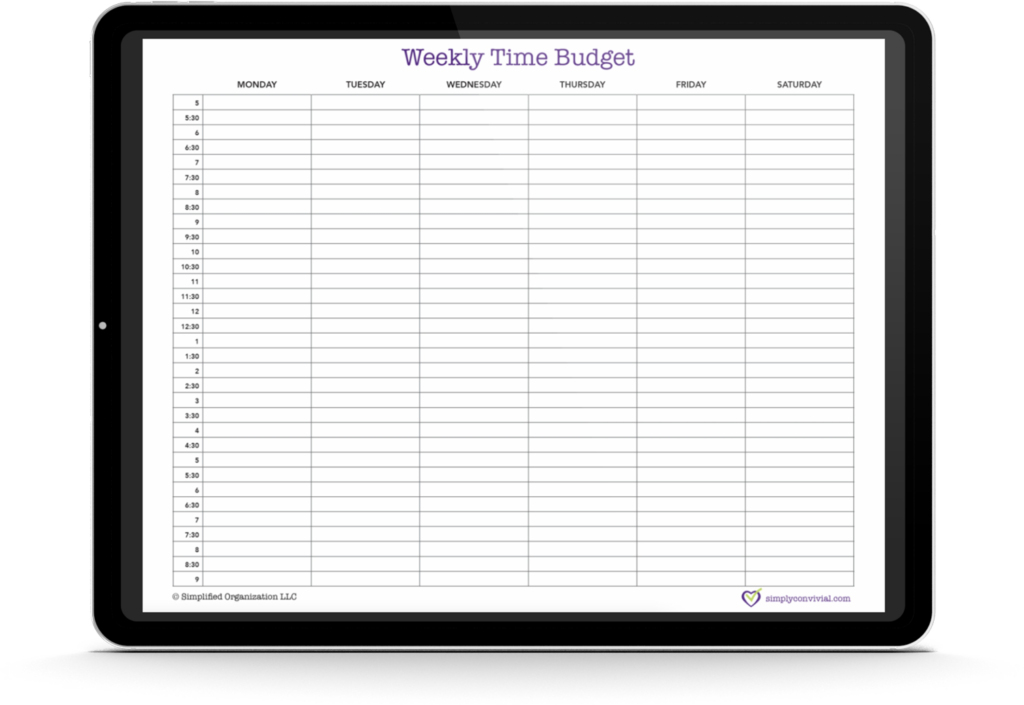
Do you need a schedule as a stay-at-home mom or not? Is it the missing piece that will finally make you organized or is it a pipe dream that will only lead to even more frustration and overwhelm?
We only have a limited amount of hours in the day, yet we have so much to do! It seems to make sense that we should plot out what needs to happen throughout that day to make sure that it all fits, to make sure that we can get it all done.
Doesn’t a schedule for a mom at home make sense? Not really. Not if we’re thinking about schedules in the same way that we think about work schedules or appointment schedules for a dentist.
Mom-life doesn’t run on schedules
Life with kids as a mom at home does not work the same way as an office or a school or any other kind of institutional setting. So schedules for moms are also going to be very different. If you’ve ever tried to make a schedule and found that it didn’t work, it’s tempting then to think that you might as well not plan at all, but that won’t help either.
Even though our days as stay-at-home moms do not fit into a rigid scheduled plan, we are still responsible for how we spend the time that we have. We should make the most of that time to do what we ought to do. That does take deliberate choices.
It’s just going to look different than maybe you think a schedule is. So let’s talk about what a schedule for moms really should look like and how to implement it without going crazy and stressing out.
Organized moms do not usually operate with a rigid schedule, but they do have a deliberate flow to how they use their time each day. Whether you call it a schedule or a routine, moms must be intentional with their time.

We all feel like there’s too much to do but with the right perspective and with realistic expectations, we can use our situation (whatever it is) for growth, for maturity, for sanctification.
So, do moms need a schedule? What kind of schedule just stay at home moms keep anyway? Are you a stay-at-home Mom who’s ever tried to use a schedule? It kind of seems like a joke.
The problem with trying schedules and finding that they don’t work is that then we are tempted to just fly by the seat of our pants and have no plan at all, to just let life happen to us, go with whatever, and not have any structure to our days.
Routine v. Schedule
But we know that children thrive on routine and the reality is that we do too, as adults, as moms.
Try as we might to escape or deny that, it’s just true of humans. But a routine is not a schedule. The two conjure up very different images in our minds. A routine is a typical pattern, things that happen in a certain order, the things that we do everyday. They just become normal. It’s the flow to our day.
A schedule, on the other hand, typically is more rigid, more structured, more imposed from the outside.
It’s much more of a constraint placed upon us maybe by our own selves, maybe by us on someone else, but a schedule implies being ruled by the clock. Operating under those kind of assumptions is probably why schedules haven’t really worked for us as moms at home because the needs that we are meeting in our home don’t generally follow the clock or a pattern.
Some days our tasks are big and all-consuming and all other plans have to go out the window. And then other days don’t require that much. So, how can we plan? What does a schedule look like for a mom?
What moms should use instead of schedules
Is it even possible for a mom to have a schedule? I think that impulse that we have to find a workable schedule is a good one.
We know that left to ourselves and our impulses we will waste a lot of time and not spend our time and attention where it needs to be.
We want to steward our time and our energy well. So we look to schedules. But too often when we do that we try to impose someone else’s schedule that they say works for them into our life and we find that doesn’t work. Then we think there’s something’s wrong with us.
But the reality is that no one else’s schedule is going to work in anyone else’s life.
We each need to do our own assessment of our needs, our situation, and come up with something, some kind of structure, that helps us make better in-the-moment decisions, that helps us make the most of the time that we have and that helps us use our time to serve the needs of our family—whatever those needs are.
You might call that a schedule, you might call that a routine, you might just call that planning.
It’s probably not going to look like half hour by half hour blocks of time each with its own specific tasks that always happens in this particular way because kids just don’t work like that. So if we have kids at home, we have to allow for them to be children and for us to be mothers to them.
Time blocking for busy moms
The kind of blocks that belong on a mom’s schedule are the kind that are big and generous with plenty of margin and that serve primarily as a reminder of where our attention needs to be.
So we don’t block off “spend half an hour with this child” and then “half an hour with this child” and check time off with our children as if it were a task that we can finish and accomplish and as if no other child is going to have needs during someone else’s time block. It’s just not the way humans or families work. And they shouldn’t. We shouldn’t try to make schedules like that.
However, we can make schedules that remind us that the laundry needs to be done right after breakfast or else it just doesn’t ever get done.
So, if I put it in this slot: after breakfast I will start the laundry. It can become a routine. It can become a habit, a pattern. And it’s kind of like a schedule.
The task happens at a certain time every day not because it’s a moral necessity, but because it’s helpful. It helps us make the most of the time and get done what needs to get done.
Most of the morning might be blocked off as homeschooling hours, or taking kids to the park, or the library—whatever the responsibilities for that day are in parenting. It might have a multi hour chunk and then there might be an hour or more chunk in the afternoon for quiet time.
We can’t forget to plan to spend some time in the kitchen every day. It takes time at certain times of the day to put three meals on the table. We need to plan for that. We need to make sure that happens.
We need to not resent the use of our time for fulfilling our duties. Instead, we simply own the work and plan to do it.
Moms need a time budget.
So, we can think through our day and think through the hours that we have and what we need to accomplish in those hours, not what we want to accomplish for our personal pet projects or our personal fulfillment, but what actual responsibilities do we have and how much time do they realistically take? Block those out.
It looks like a schedule, but I call it a time budget.
Instead of assigning tasks to every 15 minute or half hour chunk of time, we are looking with a time budget at our whole week and blocking off the big chunks of our day that are already spoken for because a lot of times what we do even when we make a schedule is think that what we plan on doing will not take as long as it actually does take, we think that we have a lot more control over our time then we actually do, we have control over ourselves but a lot of times not our time.
When we make a schedule we also often pack too much into the hours. We’re overly optimistic planners when we make hopeful planning schedules. It’s just the way it is.
In a time budget our mentality shifts. Just like our money is a finite amount of income, the amount of time coming in is also finite. And, just as with money budgets, some “expenses” are variable, some are unexpected, and some are fixed.
We can’t plan to use all of our income for all discretionary spending purposes at whim without first taking into account those fixed living expenses, right?
In the same way, a budget for our time takes the fixed income of time that we are given each day or week and takes out those fixed living expenses first. When you do that and mark off the time that it actually takes to make the meals every day, to make sure the laundry gets done, block off time for parenting, block off nap time, or grocery shopping time, whatever regularly occurring appointments you have, then you see what’s left over.
Schedules v. Time Budgets
Sometimes you might see that the reason you feel crazy is that you don’t have any margin time. You don’t have any extra time. Yet you’re making to-do lists as if you had multiple extra hours a day to get more done.
That’s frustrating because it’s having expectations that are outside the bounds of reality. So a time budget is a way for us to concretely see on paper the reality of our life’s responsibilities right now.
Then we can move forward with that and take that into account, make realistic to-do lists each day, and spend our time where it really counts because we’re looking at that bigger picture.
We are taking into account what we actually need to spend time doing, and seeing where our time does go. It’s okay that a lot of time goes towards our responsibilities rather than our hobbies or desires or ideals or projects. Often we don’t have much time left over for that and that’s okay.
A time budget will help us be realistic as we make a schedule for the remaining time that we have during the day at home and it’s a great reminder that time is finite and everything we do uses some of that time.
Having a time budget, referring to it, filling it out is more descriptive than prescriptive. A schedule is usually trying to cram our perfect ideal day into the hours.
Whereas a time budget takes those fixed expenses, puts them into the week, and then looks at what is left over to budget in more discretionary ways. This allows us to be realistic. This allows us to give ourselves a margin and to use our time in a less frantic, rushed and stressed way.
A time budget might look like a schedule, but really it’s a way of assessing how we are using our time so we can make smart stewarding decisions with the limited time that we are given.





